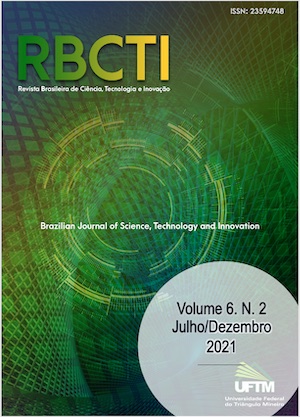Efeito da textura superficial em insertos de metal duro revestidos de TiAlN e Mínima Quantidade de Lubrificação no torneamento do aço SAE 4340
DOI:
https://doi.org/10.18554/rbcti.v6i2.5482Palavras-chave:
Laser, Texturização, MQL, Torneamento, TiAlNResumo
A texturização a laser de superfícies é um método atualmente muito popular, a sua aplicação resulta em diversos benefícios em diferentes áreas, como a área de metal mecânica, especificamente, a usinagem. Na usinagem a texturização a laser pode aumentar a vida de ferramentas de corte por aumentar a adesividade dos revestimentos cerâmicos sobre o substrato. Além disso, a textura ordenada da superfície pode alterar a interação entre a ferramenta e a peça na zona de corte, tanto para a usinagem a seco quanto para usinagem com fluido de corte. O objetivo deste trabalho consiste em comparar por meio de ensaios de vida de ferramentas e acabamento superficial da peça usinada no torneamento do aço SAE 4340 a seco e com aplicação de fluido de corte por jorro e MQL (Mínima Quantidade de Lubrificante), insertos de metal duro da classe ISO P modificados superficialmente, por meio de texturização a laser e jateamento, e posteriormente revestidos de TiAlN (Nitreto de Titânio). Os resultados mostraram um melhor desempenho nos ensaios de vida dos insertos texturizados por jateamento, e um melhor acabamento da peça torneada com a utilização do revestimento TiAlN, tanto para o substrato jateado quanto texturizado a laser em relação a ferramenta sem revestimento. A aplicação de fluido de corte por MQL mostrou-se eficiente nos ensaios de vida, aumentando a vida das ferramentas, excepcionalmente, na ferramenta TiAlN-jateada. Nos ensaios de acabamento superficial, medição da rugosidade média aritmética (Ra), a aplicação de MQL não se mostrou eficiente. A caracterização superficial por MEV (Microscopia Eletrônica de Varredura) mostrou que a ferramenta TiAlN-laser sofreu um destacamento precoce do revestimento, o que provavelmente justifica o seu pobre desempenho nos ensaios de vida.
Referências
BLATTER, A.; MAILLAT, M.; PIMENOV, S. M.; SHAFEEV, G. A.; SIMAKIN, A. V.; LOUBNIN, E. N. Lubricated sliding performance of laser-patterned sapphire. Wear, v. 232, n. 2, p. 226-230, 1999. DOI: https://doi.org/10.1016/S0043-1648(99)00150-7.
CORFE, A. G. Laser drilling of aero engine components. In: Proceedings of the First International Conference on Lasers in Manufacturing. Brighton, U.K., 1983.
DGUV. Minimum quantity lubrication for machining operations. Publisher Deutsche Gesetzliche Unfallversicherung (DGUV), Edition November, 2010. 84 p.
KAMATA, Y.; OBIKAWA, T. High speed MQL finish-turning of Inconel 718 with different coated tools. Journal of Materials Processing Technology, v. 192-193, p. 281-286, 2007. DOI: https://doi.org/10.1016/j.jmatprotec.2007.04.052.
LEYLAND, A.; MATTHEWS, A. On the significance of the H/E ratio in wear control: a nanocomposite coating approach to optimized tribological behavior. Wear, v. 246, n. 1-2, p. 1-11, 2000. DOI: https://doi.org/10.1016/S0043-1648(00)00488-9.
LIMA, M. S. F.; NEVES, D.; DINIZ, A. E. Machining with a laser treated tool steel drill: surface and tool life aspects. In: I International Conference on Heat Treatment and Surface Engineering of Tools and Dies, Pula-Croatia, 2005.
LOW, D. K. Y.; LI, L.; CORFE, A. G.; BYRD, P. J. Spatter-free laser percussion drilling of closely spaced array holes. International Journal of Machine Tools & Manufacture, v. 41, n. 3, p. 361-377, 2001. DOI: https://doi.org/10.1016/S0890-6955(00)00078-X.
MACHADO, A. R.; SILVA, L. R. R.; SOUZA, F. C. R.; DAVIS, R.; PEREIRA, L. C.; SALES, W. F. et al. State of the art of tool texturing in machining. Journal of Materials Processing Technology, v. 293, p. 1-23, 2021. DOI: https://doi.org/10.1016/j.jmatprotec.2021.117096.
NEVES, D.; DINIZ, A. E.; LIMA, M. S. F. Efficiency of the laser texturing on the adhesion of the coated twist drills. Journal of Materials Processing Technology, v. 179, n.1-3, p. 139-145, 2006. DOI: https://doi.org/10.1016/j.jmatprotec.2006.03.068.
PERVAIZ, S.; ANWAR, S.; QURESHI, I.; AHMED, N. Recent advances in the machining of titanium alloys using minimum quantity lubrication (MQL) based techniques. International Journal of Precision Engineering and Manufacturing-Green Technology, v. 6, p. 133-145, 2019. DOI: https://doi.org/10.1007/s40684-019-00033-4.
SAID, Z.; GUPTA, M.; HEGAB, H.; ARORA, N.; KHAN, A. M.; JAMIL, M. et al. A comprehensive review on minimum quantity lubrication (MQL) in machining processes using nano-cutting fluids. The International Journal of Advanced Manufacturing Technology, v. 105, p. 2057-2086, 2019. DOI: https://doi.org/10.1007/s00170-019-04382-x.
SANTOS, S. C. Estudo da Influência de Revestimentos e da Aplicação de Fluido de Corte no Desempenho de Brocas de Aço-Rápido e de Metal Duro Integral na Usinagem de Ferro Fundido Cinzento. Tese (Doutorado em Engenharia Mecânica) - Universidade Federal de Uberlândia, Faculdade de Engenharia Mecânica, Uberlândia, MG, 2002. 192 p.
SUH, C. M.; HWANG, B. W.; MURAKAMI, R. I. Behaviors of residual stress and high temperature fatigue life in ceramic coatings produced by PVD. Materials Science and Engineering A, v. 343, n. 1-2, p. 1-7, 2003. DOI: https://doi.org/10.1016/S0921-5093(02)00327-1.
SUN, Y.; BLOYCE, A.; BELL, T. Finite element analysis of plastic deformation of various TiN coating/substrate systems under normal contact with a rigid sphere. Thin Solid Films, v. 271, n. 1-2, p. 112-131, 1995. DOI: https://doi.org/10.1016/0040-6090(95)06942-9.
WATANABE, K.; NATSUME, J.; HASHIZUME, K.; OZASA, T. O.; NADA, T.; MASUDA, Y. Theoretical analysis of bearing performance of microgrooved bearing. JSAE Review, v. 21, n. 1, p. 29-33, 2000. DOI: https://doi.org/10.1016/S0389-4304(99)00073-9.
Downloads
Publicado
Edição
Seção
Licença
Copyright (c) 2022 Rhander Viana, Luiz Eduardo Rodrigues Vieira

Este trabalho está licenciado sob uma licença Creative Commons Attribution-NonCommercial-ShareAlike 4.0 International License.




